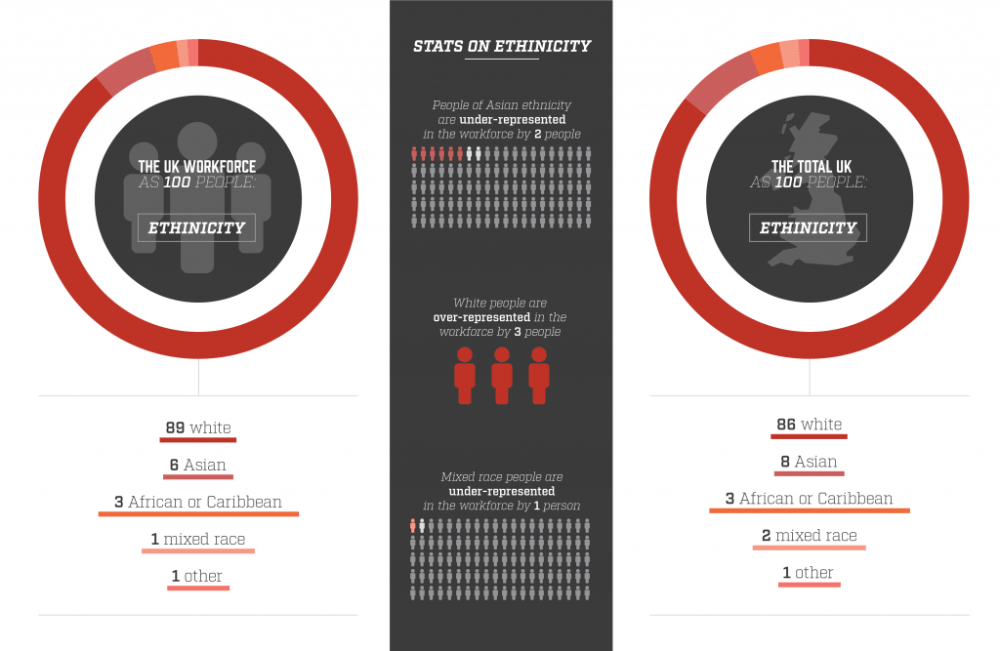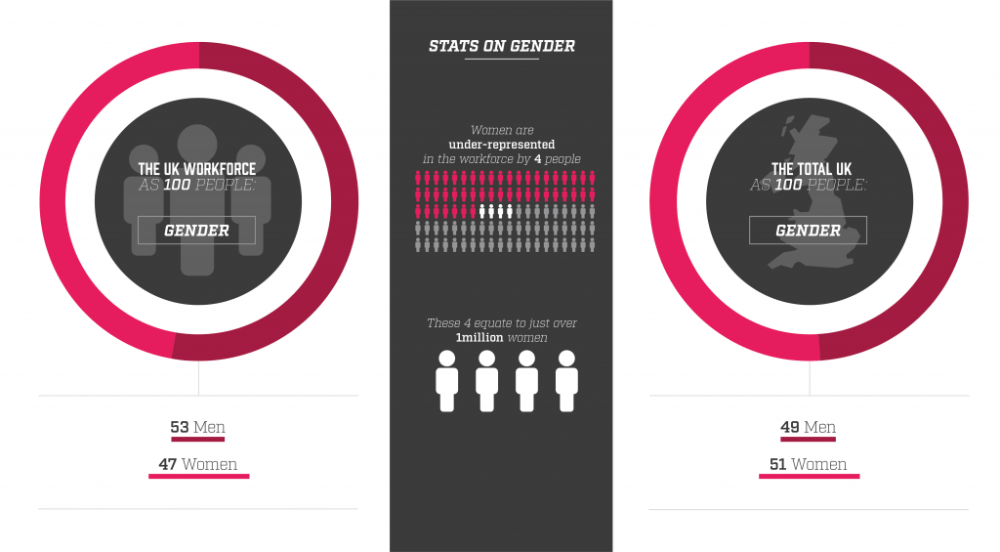People in the UK are lucky to live in a multicultural society, where a variety of livelihoods are brought together by people of different nationalities, races and religions. This means that understanding the importance of diversity in the workplace is more important than ever.
With almost 30 million people making up the UK workforce, it can be hard to gauge just how equally represented it is.
Office furniture and stationery suppliers Viking Direct recently conducted a study, aiming to visualise the makeup of the UK workforce, and help businesses understand where they should be in terms of diversity in their own organisation.
How does it work?
To analyse the makeup of a group of almost 30 million people would present a very difficult task, this is why the study was downsized to show the UK population and its workforce as 100 people. This provides an insight into any noticeable differences when comparing statistics on the population and workforce.
Using census data from the Office of National Statistics, they analysed nine points and split these into different groups that could be found in the working population of the UK. Each point was then calculated as a percentage of a whole and rounded up or down to give the number out of 100 for each factor.
There were various factors examined as part of the research, this included insight into the biggest industries in the UK, how diverse the workforce is and how working hours look across the nation.
This information could then be used by employers and applied to their own businesses.
Ethnicity
The UK is an ethnically diverse nation, and this has many far-reaching benefits. The general population as 100 would include 86 white people, 8 Asian, 3 African or Caribbean, 2 mixed race and 1 other.

When it comes to the workforce, however, there is an imbalance. Viewing the workforce as 100, there would be 89 white people, this is an over-representation of three.
There would be six Asian members of the workforce, an under-representation of two, whilst mixed-race people would account for one person, an under-representation of one.

UK workforce ethnicity
Gender
In the UK in general, when broken down to 100 people, women outnumber men by 51 to 49. This means that you’d expect there to be more women represented in the workforce than men.
Ensuring that women are correctly represented in the workforce has been an issue for many years, and this issue is highlighted by the research. As part of the workforce as 100, women account for 47 people.
This means that women are under-represented in the workforce by four people, a number which may not seem like much; however, this roughly converts to just over one million women.

UK workforce by gender
Religion
Once again, thanks to the UK having a culturally diverse society, it has a population.
With the population broken down to 100 people, this would mean there are 59 Christians, 25 people of no religion, 7 who didn’t state a religion, 2 that were classed as ‘other’ and include Buddhism, Judaism and Sikhs, 5 Muslims and 2 Hindus.
This shows a clear dominance for Christianity, but a wide variety from non-religious to Muslim.
In the workforce as 100, Christians are under-represented by 1. There is also under-representation when it comes to Muslims (2) and Hindus (1), however, people of no religion were over-represented in the workforce by 4.
All of this does still show that there is diversity within the workforce, however, there is a general leaning towards people of no religion that could be corrected.

UK workforce by religion
Health
Health can be a big factor in whether someone is able to work or not and can determine the number of hours they’re able to work in a role. In the UK in general, 47 people are in very good health, 34 in good health, 13 would describe themselves as in fair health, 5 in bad and 1 in very bad health.
The good news for the UK is that 81% of the nation are in good or very good health.
When it comes to the workforce, it’s important for those with health problems to feel welcome and accommodated in the workplace.
In the UK, people with good health are over-represented by 6 people. In contrast to this, both people in fair health and people in bad health are under-represented by 4 people.

UK workforce by health
How can workplaces ensure diversity in their workforce?
Whilst the workforce as 100 is by no means a concrete model for exactly how the modern workforce should look, its certainly helpful in assessing where there are gaps and sparking conversation as to how workplaces can ensure they are remaining inclusive.
There are several steps that can be made by all employers to help make sure that everyone feels welcome in their business.
Diversity assessments
Conducting a diversity assessment is a great way for any business to get a clear idea of where it stands when it comes to diversity across the workforce. Conducting a diversity analysis of your business doesn’t have to be an expensive or time-consuming task. Look at factors such as the gender, religion and ethnicity of your staff and convert these into percentages.
Once you’ve done this, you can compare these figures to those presented by this study and you’ll gain a clearer idea of how your business performs compared to other companies when it comes to diversity.
Conducting a diversity assessment makes it possible for your business to highlight and potentially correct any areas in which you fall short.
Make sure you have the right environment
Organisations should be equipped to facilitate people from all backgrounds and groups. For instance, does your office have a private space for prayer? Is it accessible to wheelchair users?
Any diversity issues may not be caused by direct recruitment problems, more so, you may find that people are put off working for your company due to a lack of facilities to make their working life comfortable.
The general atmosphere and culture within a business can make a big difference. Making sure that you help to cultivate a business that is inclusive is very important. Try to encourage team bonding with social activities.
On that note, ensure that those social activities work for everyone, for example, centring an activity around alcohol may mean you leave certain team members out if they don’t drink.
Consider recruitment
Recruiting staff is one of the hardest challenges faced by any business. Attracting the people who fit within your company culture and help to create a diverse workforce can be tough.
Positively discriminating in order to meet any sort of diversity target is wrong but making sure your job adverts don’t use gendered language will help everyone feel welcome when considering an application.
Similarly, find the right places to advertise opportunities in your business. Research has shown that males and females approach job hunting in very different ways, so make sure you’re spreading your search across multiple channels where you’re likely to find a diverse selection of people.
In Summary
The workforce as 100 study isn’t designed to preach to employers and tell them exactly how they should make up their workforce, however, it does offer an interesting insight into how the UK’s workforce currently looks and where we can all work to improve its diversity.
About the Author
Mark Wiggins is a writer based in Leeds, England. With years of people management experience, he specialises in writing about employee motivation and human resources.



